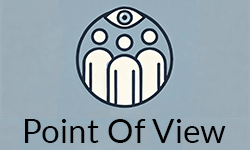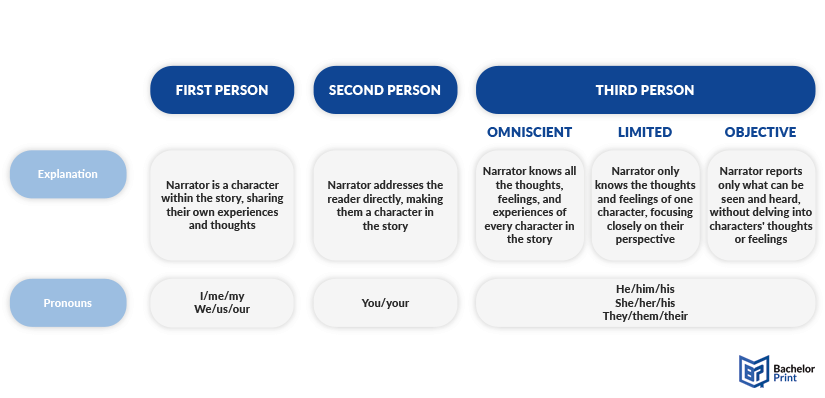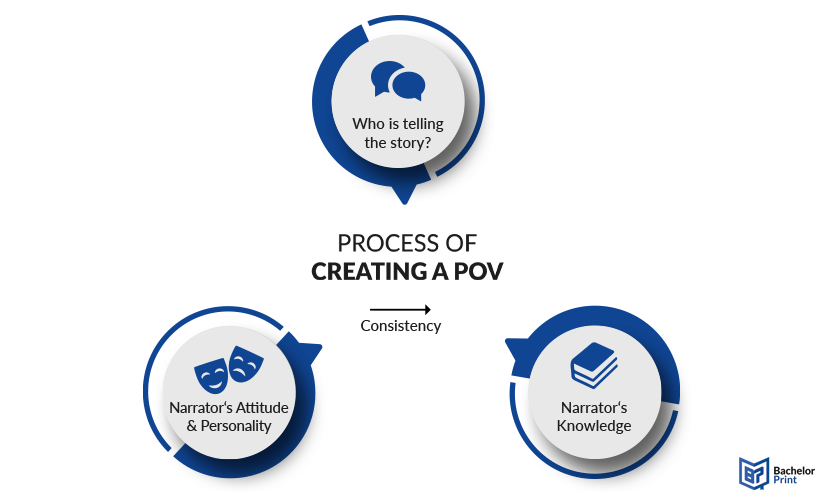
In the realm of storytelling and literature, the concept of “point of view” serves as a cornerstone that shapes how narratives unfold and how readers engage with the text. This concept is not only vital in creative writing but also plays a crucial role in academic writing, where adhering to language rules is key. You will find a POV in every type of writing and every style of book, even this article, making it an indispensable tool for effective communication and analysis.
Definition: Point of view
The noun “point of view” refers to the perspective from which a story is narrated, or a situation is considered. In literature and storytelling, it determines through whose eyes the events are seen and who tells the story. There are several types of points of view:
- First person
- Second person
- Third person
In a broader context, “point of view” can also refer to an individual’s perspective, opinion, or attitude towards a particular issue or situation.

First-person point of view
The first-person point of view is when the narrator is a character within the story, using pronouns like “I” and “we” to tell the story from their perspective. The first-person POV can be written in the singular form or plural form. Simply consider the numerus (grammatical number) when choosing the pronouns.
The reader only knows what the narrator knows, which may limit the scope of the story. It can also vary in reliability. An unreliable first-person narrator may provide a biased or distorted view of events. An unreliable narrator does not have to be negative because it opens ways to a whole new way for your type of writing.
Young adult, science fiction, and memoirs typically use the first-person POV.
Second-person point of view
The second-person point of view addresses the reader directly using the pronoun “you,” making the reader a character in the story. Writing in the second person creates an immersive and interactive experience, drawing the reader directly into the narrative and making them feel like an active participant. This can create an intimate reading experience when executed well.
Due to the narrative of the piece of writing, the reader is emotionally involved and cannot concentrate for a longer full stop, making it more suitable for rather short types of works. Genres commonly using this POV are creative fiction and nonfiction.
Third-person point of view
The third-person point of view uses third-person pronouns like “he,” “she,” or “they,” or character names. The narrator exists outside the story and can vary in knowledge about different character quirks or their thoughts and feelings. Here are the three types of third-person narrations:
- Third-person limited: Narrative focuses on the thoughts and feelings of only one character.
- Third-person omniscient: All thoughts, actions, and feelings of every character are known.
- Third-person objective: Events are reported without delving into characters’ thoughts or feelings.
Writing in the third-person narration offers flexibility in storytelling, allowing for a broader perspective and a more objective or comprehensive view of the narrative.
In third-person limited narration, a perspective that is confined to the thoughts, feelings, and experiences of a single character is provided. This creates a focused and intimate narrative. This approach allows readers to connect deeply with compelling characters while maintaining a degree of narrative distance. Limited narrators can effectively convey the inner world of the protagonist, making their motivations and emotions clear, while still leaving other characters more mysterious. This contrast between the known and the unknown can heighten tension and intrigue in the story.
Genres that typically use a third-person limited narration are romance and thrillers.
The third-person omniscient point of view provides a comprehensive and all-knowing perspective, where the narrator has access to the thoughts, feelings, and experiences of all characters in the story. This approach allows the narrative to shift between different characters’ viewpoints, offering a broader and more complex understanding of the plot and dynamics between characters. The omniscient narrator can reveal motivations, secrets, and internal conflicts, enriching the storytelling with multiple layers of insight.
Fantasy fiction and literary fiction commonly use a third-person omniscient POV.
The third-person objective point of view presents the story without delving into the thoughts or feelings of any characters. The narrator reports only what can be observed, like an impartial observer or a camera recording events. This perspective allows readers to interpret characters’ actions and dialogue without narrative bias.
The third-person objective POV can be particularly effective in genres that benefit from an impartial narrative, allowing readers to draw their conclusions about characters and events. These genres include but are not limited to journalistic writing, crime and detective fiction, and modernist literature.
Fourth-person point of view
A fourth-person point of view is not a standard term in narrative theory. However, some discussions and experimental literary works explore the idea, generally referring to a more abstract or collective narrative perspective. This concept can be implemented in a few different ways:
- A narrative voice that represents a group or collective entity, rather than an individual central character. This might involve using pronouns like “we” or “us” in a way that speaks for a community or a species.
- A perspective that acknowledges and interacts with the storytelling process itself, sometimes breaking the fourth wall and addressing the reader directly or commenting on the narrative structure.
- A point of view that goes beyond individual or collective human experiences, possibly involving a more universal, philosophical, or omnipresent perspective.
While these are not widely recognised as a formal “fourth person” in traditional narrative theory, they represent ways in which authors can experiment with narrative perspectives beyond the conventional first, second, and third person.
Process
Creating a point of view involves deciding from which perspective the story will be told and how much information the narrator will have access to.
- First, you should decide who is telling the story. Is it a character within the story (first person), a narrator who addresses the reader directly (second person), or an external narrator (third person)?
- Then, decide how much the narrator knows. Will the narrator know everything about all characters (omniscient), or will they have limited knowledge focused on one or a few characters (limited)?
- In the next step, you define the narrator’s attitude and personality. Are they reliable or unreliable? Do they have biases or a unique voice that colors the narration?
- Lastly, ensure the narrator’s voice remains consistent throughout the story. This includes their tone, language, and perspective.

Famous examples
Throughout the history of literature, numerous authors have employed diverse points of view to craft captivating and memorable works. This section examines notable instances where the chosen point of view has a significant impact on the narrative, illustrating the diverse ways in which the perspective can be utilized to enhance storytelling. From first-person introspection to third-person omniscient narration, these pieces of writing highlight the power of perspective in literature.
This excerpt from Herman Melville’s “Moby-Dick” is written in the first person. The “I” in this narrative is Ishmael, the central character, who directly shares his personal thoughts and experiences with the reader. This point of view creates an intimate and immersive experience, allowing readers to connect closely with Ishmael’s emotions and personal perspective. First-person writing is often used to provide a deep, subjective understanding of the narrator’s character.
This excerpt from Jay McInerney’s “Bright Lights, Big City” is written in the second person. The “you” refers to the protagonist, drawing the reader directly into the narrative as if they are the main character. This point of view creates an immersive reading experience, making the reader feel as though they are living the events themselves. Second-person POV is typically used to create a sense of immediacy and personal involvement.
In this third-person narrative from Ernest Hemingway’s “The Old Man and the Sea,” the story is told from an external perspective using “he.” This is an example of third-person limited POV, where the narrator provides insight into the experiences and thoughts of a single character. This point of view allows the reader to understand the protagonist’s feelings and motivations while maintaining some narrative distance, offering a balance between intimacy and objectivity.
In William Faulkner’s “A Rose for Emily,” the narrator uses “we” and “our” to speak from the collective perspective of the townspeople. The “we” represents the shared views and memories of the community regarding Miss Emily’s actions and history. This collective narrative voice provides insight into the communal mindset and collective judgment of the townspeople, illustrating how they perceive and respond to Miss Emily’s life.
Change of point of view
The point of view within a story can be changed, and many authors do switch from character to character to achieve various narrative effects. However, changing the POV should be done thoughtfully to avoid confusing the reader. Here are some common ways to change it effectively:
| Method | Description |
| Chapter/section breaks | Switching POVs between chapters or sections is a common method. Each chapter or section can be narrated from a different character’s perspective. |
|
Clear indicators |
Use clear indicators, such as the character’s name or a distinctive style, at the beginning of a new section to signal a POV change. |
|
Consistent patterns |
Maintain a consistent pattern when switching POVs. For example, alternating between two characters’ perspectives can create a rhythm. |
| Limited third-person | Some stories use multiple third-person limited perspectives, switching between different characters while maintaining this narration. |
| Omniscient narrator | An omniscient narrator can shift between characters’ thoughts and experiences more freely, as this type of narration has an all-knowing perspective. |
Note: While POV changes can add depth and complexity to a story, it’s important to ensure that transitions are smooth and clear to maintain reader engagement and understanding all throughout the entire book.
Academic writing
So, which point of view is used in academic writing, like theses, dissertations, research papers, and the like? Typically, the third-person point of view is used. This perspective helps maintain a formal tone and objective stance, which is important for scholarly work. It focuses on presenting information, analysis, and arguments without referring to the author directly. Pronouns like “he,” “she,” “it,” “they,” and specific nouns are commonly used, rather than first-person pronouns like “I” or “we.”
Using third-person POV helps ensure that the writing remains professional and unbiased, emphasizing the research rather than the researcher.
Note: Sections like acknowledgments, prefaces, or personal statements in theses and dissertations may use the first person to express gratitude or provide personal context.
Synonyms for “point of view”
If you feel unsure about the correct spelling or usage of the “point of view” in sentences, it may be helpful to use synonyms for it. This way you can grasp a thorough understanding of it and use the term correctly.
Simultaneously, you can avoid repetition and redundancy in your academic work. The table below illustrates alternative words for “point of view” and respective examples of how to use them properly in sentences.
| Synonyms | Examples |
| Perspective | Your point of view shapes how you perceive the world. |
| Your perspective shapes how you perceive the world. | |
| Angle | Each character in the story has a unique point of view. |
| Each character in the story has a unique angle. | |
| Standpoint | From an environmental point of view, reducing waste is more crucial than ever. |
| From an environmental standpoint, reducing waste is more crucial than ever. | |
| Opinion | From my point of view, the benefits of urban green spaces far outweigh the costs. |
| In my opinion, the benefits of urban green spaces far outweigh the costs. |
FAQs
“In your point of view” is a phrase used to ask for someone’s personal opinion, perspective, or interpretation on a matter. It invites the individual to share their thoughts, beliefs, or feelings based on their personal experiences, knowledge, and reasoning.
This phrase acknowledges that the response will be subjective and influenced by the individual’s unique position, background, and insights. It’s a way of understanding how someone perceives a situation or issue from their standpoint.
- 1st person: The narrator is a single character in the story and uses first-person pronouns, like “I” or “we.”
- 2nd person: The narrator speaks directly to the reader using the pronoun “you.”
- 3rd person: The narrator is outside the story and uses pronouns like “he,” “she,” “they,” or names.
There are three POVs:
- First person
- Second person
- Third person
Technically, there is a fourth-person POV; however, it is used rather rarely.
Below, you’ll find a known work written in the respective POV.
First-person example:
- “The Catcher in the Rye” by J.D. Salinger
Second-person example:
- “Bright Lights, Big City” by Jay McInerney
Third-person example:
- “Harry Potter and the Sorcerer’s Stone” by J.K. Rowling
- ✓ 3D live preview of your individual configuration
- ✓ Free express delivery for every single purchase
- ✓ Top-notch bindings with customised embossing

